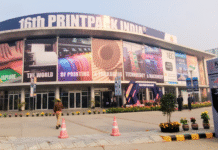The Assam Tribune, published from Guwahati in Assam, is the highest circulated English daily in northeast India. Founded in 1939 in Guwahati, it has been in circulation for 84 years. Correspondent Priyanka Tanwar visited the newspaper’s office in Chandmari, Guwahati, in September 2022 and interacted with its executive editor PJ Baruah to gain insight into the publications’ strategies to cope with the pandemic, the annual Assam floods, newsprint challenges and the digital news media invasion.
IPP – Please tell us how the increase in newsprint prices has affected your production cost.
PJ Baruah – Newsprint prices have been going up. The industry has appealed to the union government to cut the excise duty so that we can face the situation – especially after Covid when the sector has taken a big blow. Most newspapers in the country are facing big economic challenges today. During Covid, there was a large-scale reduction of circulation along with a fall in ad revenue because the economy was locked down. Because of all these factors, the economy was moving at a slow pace. It was a very big challenge for the industry.
In Assam also, we had to face a very big challenge. During this time of crisis, the state government helped the industry out in a big way with some increased advertising. Since production costs are on the higher side, it affected our circulation. Even if there is a demand to circulate more newspapers and the revenue stays constant, it adds to the production cost. This is a time when the government should come forward to assist the industry with some incentives so that we can overcome the crisis.
Another dimension is the Ukraine war. A lot of newsprint used to come from Ukraine at a reduced cost and its stoppage has added to the newsprint shortage in the country. Now we have to depend on higher priced newsprint from other sources, which adds to the production cost. The ad revenue is also not going up as expected.
IPP – What distribution issues do you face during floods?
PJ Baruah – Floods are an annual feature in Assam. This time it was a bit different as we had pre-monsoon floods, which were unexpected at that time of the year. The floods hit the hill districts such as Karbi Anglong and Dima Hasao as well as the Barak Valley – areas that were earlier not susceptible to or vulnerable to floods. This time, there was very heavy rainfall as compared to earlier times, resulting in landslides, erosion and other problems. We have dams in the mountains. More rainfall means the dams had to release the water. This resulted in floods in the catchment areas.
Our circulation is affected because we cannot deliver the newspaper to the doorstep of our readers since most areas are flooded and marooned. You cannot reach them unless you take a boat. These are logistics problems that you cannot solve overnight. These challenges are always with us. But one good thing about the Assam floods is that they don’t stay long – the water drains out and as soon as the weather improves. Some sort of normalcy comes in and people living in flood shelters or relief camps slowly make their way back. Unlike newspapers, electronic TV channels and digital media can always reach their viewers and readers. This is a major challenge for the print industry but something we have to take in our stride.
IPP – Would you like to comment on the interest of the younger generation in digital news media?
PJ Baruah – I think this is a very worldwide phenomenon and not something restricted to Assam or India. The new generation or young children don’t read newspapers. If there are a hundred students and you ask how many read newspapers – at the most about five to 10 hands will go up. I think this is a generational shift with the coming of the smartphone where you can get news and other things at the press of a button.
I believe newspaper reading is very important and I think many educators and other concerned citizens will agree with me. The habit of reading newspapers should be inculcated in children by parents or teachers from a very young age as it will help them in their selection of a career, in making them good citizens or in expanding their knowledge base through a better understanding of issues. I believe reading books and newspapers is the foundation of a good education and good citizenship. Reading newspapers regularly better equips one to know the issues, have better awareness of what’s happening in the state, in the country or in the world at large.
Teachers and parents have a big role to play in inculcating the habit because you just cannot say that my child doesn’t read. I find many parents boasting that their child doesn’t read a newspaper. We have to take the children back to reading newspapers. Reading something in hard copy is very different from reading on the smartphone or the laptops.
Even our prime minister had said at a public function that reading newspapers is very important. If a person of his experience and knowledge says this, it goes a long way in our advocacy for reading newspapers. We still have elderly people here who say that they grew up reading the Assam Tribune or that I learned my English by reading the Assam Tribune.
What I have found from my own experience is that reading a newspaper makes you aware of your people and your state’s issues and you become more involved with your society.
IPP – Many Assamese and Indian newspapers have shut down in the recent past. How are you dealing with these tough times?
PJ Baruah – It’s a big challenge. As I have already told you, during the Covid time, many newspapers and magazines shut down as they couldn’t afford the expenses. Reading habit has gone down. Even weeklies and monthlies don’t have a place in today’s media world. The few magazines that are surviving are in bad shape. Newspapers are facing big challenges. Pre-Covid there was at least some commercial aspect. After all, newspapers and magazines are products and we have to sell them. You have to get the advertisements because Indian magazines and newspapers are highly subsidized.
If the production cost of a copy is about fifteen rupees, we are selling it for eight rupees, which is a clear loss of seven rupees, which we hope to make up from advertisement and circulation revenue. During the Covid-19 pandemic, there were no ads and the circulation came down. So how do you survive? We also have to pay salaries to our staff and employees.
In fact, I think Indian newspapers are the lowest priced products in the world! And even then people don’t buy them! Even if you go to Bangladesh, a newspaper might cost about thirty rupees, if you go to Pakistan, it might be forty-fifty rupees. Their newspaper price is according to their cost of production; their ad revenues are never taken into consideration while fixing the price of the newspaper. But in India it’s the other way around. Indian newspapers are priced at eight rupees or ten rupees, which is just the cost of a cigarette. You’ll find people smoking cigarettes but they won’t pay ten rupees to buy a newspaper.
We recently made our ePaper subscription-based because we find that many people prefer to read our content on the internet. I thought it’s better to ask them to pay a nominal amount to read the paper.
IPP – What challenges do you face from digital and TV media?
PJ Baruah – These are big challenges that we have to face. Even in the villages, at the press of a button, people can see so many news channels. Many villagers have stopped subscribing to newspapers because they are paying to view the TV channels. Doordarshan was free but now you have a package with news channels, sports, cartoons, movies and entertainment channels. So people don’t want to pay double.
Earlier, people used to buy the newspapers to know the news, read articles, because there was no TV. But newspapers have their own charm. We have our own style of operating.
IPP – Have you adopted any new technologies in your printing presses after the Covid-19 pandemic?
PJ Baruah – We have not updated our printing technologies because the pandemic has hit our finances. Before the pandemic, we had tried to update our printing presses. Some benefits earlier given to our employees have been curtailed because of our financial position. I think new presses or technology will take some time.
















